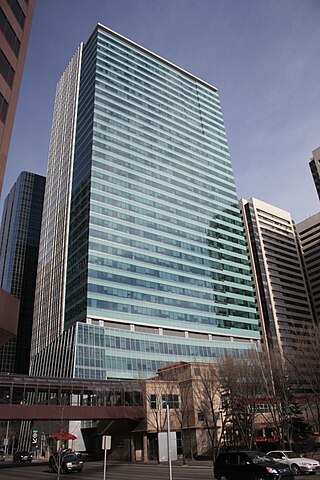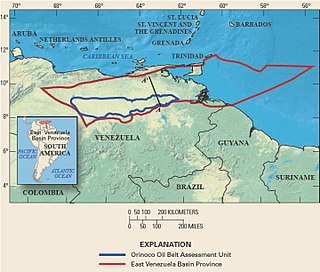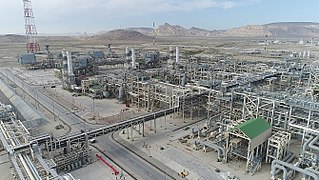Related Research Articles
Enbridge Inc. is a Canadian multinational pipeline and energy company headquartered in Calgary, Alberta, Canada. Enbridge owns and operates pipelines throughout Canada and the United States, transporting crude oil, natural gas, and natural gas liquids, and also generates renewable energy. Enbridge's pipeline system is the longest in North America and the largest oil export pipeline network in the world. Its crude oil system consists of 28,661 kilometres of pipelines. Its 38,300 kilometre natural gas pipeline system connects multiple Canadian provinces, several US states, and the Gulf of Mexico. The company was formed by Imperial Oil in 1949 as the Interprovincial Pipe Line Company Limited to transport Alberta oil to refineries. Over time, it has grown through acquisition of other existing pipeline companies and the expansion of their projects.

A floating production storage and offloading (FPSO) unit is a floating vessel used by the offshore oil and gas industry for the production and processing of hydrocarbons, and for the storage of oil. An FPSO vessel is designed to receive hydrocarbons produced by itself or from nearby platforms or subsea template, process them, and store oil until it can be offloaded onto a tanker or, less frequently, transported through a pipeline. FPSOs are preferred in frontier offshore regions as they are easy to install, and do not require a local pipeline infrastructure to export oil. FPSOs can be a conversion of an oil tanker or can be a vessel built specially for the application. A vessel used only to store oil is referred to as a floating storage and offloading (FSO) vessel.
Tengiz field is an oil field located in Zhylyoi District, Atyrau Region, northwestern Kazakhstan.

TC Energy Corporation is a major North American energy company, based in the TC Energy Tower building in Calgary, Alberta, Canada, that develops and operates energy infrastructure in Canada, the United States, and Mexico. The company operates three core businesses: Natural Gas Pipelines, Liquids Pipelines and Energy.

Sonatrach is the national state-owned oil company of Algeria. Founded in 1963, it is known today to be the largest company in Africa with 154 subsidiaries, and often referred as the first African oil "major". In 2021, Sonatrach was the seventh largest gas company in the world.

The China National Petroleum Corporation (CNPC) is a major national oil and gas corporation of China and one of the largest integrated energy groups in the world. Its headquarters are in Dongcheng District, Beijing. CNPC was ranked fourth in 2022 Fortune Global 500, a global ranking of the largest corporations by revenue.

The Orinoco Belt is a territory in the southern strip of the eastern Orinoco River Basin in Venezuela which overlies the world's largest deposits of petroleum. Its local Spanish name is Faja Petrolífera del Orinoco.
Kashagan Field is an offshore oil field in Kazakhstan's zone of the Caspian Sea. The field, discovered in 2000, is located in the northern part of the Caspian Sea close to Atyrau and is considered the world's largest discovery in the last 30 years, combined with the Tengiz Field. When discovered, it was the second largest oil field in the world.

The Caspian Pipeline Consortium (CPC) is a consortium and an oil pipeline to transport Caspian oil from Tengiz field to the Novorossiysk-2 Marine Terminal, an export terminal at the Russian Black Sea port of Novorossiysk. It is one of the world's largest pipelines and a major export route for oil from the Kashagan and Karachaganak fields. The CPC pipeline transfers about 1% of global oil supply and handles almost all of Kazakhstan's oil exports. In 2021, the pipeline exported up to 1.3 million barrels per day (bpd) of Kazakhstan's main crude grade, light sour CPC Blend, which represented 80% of Kazakhstan's total oil production of 1.6 million bpd.
Azeri–Chirag–Gunashli or Azeri–Chirag–Deepwater Gunashli is a complex of oil fields in the Caspian Sea, about 120 kilometres (75 mi) off the coast of Azerbaijan. It consists of the Azeri and Chirag oil fields, and the deepwater portion of the Gunashli oil field. An overall estimate of the area of the development is 432.4 square kilometres (167.0 sq mi). It is developed by the Azerbaijan International Operating Company, a consortium of international oil companies, and operated by BP on behalf of the consortium. The ACG fields have estimated recoverable reserves of about 5 to 6 billion barrels of petroleum. Peak oil production of 835,000 barrels per day (132,800 m3/d) was reached in 2010, however by the first quarter of 2022 production had declined to 434,000 barrels per day (69,000 m3/d), or about one-half of peak value. As of 2021, ACG oil accounted for 95% of all Azerbaijani oil exports.
Jack J. Grynberg was an American businessman. He was a Denver-based oil and gas developer who amassed a multibillion-dollar fortune in the oil and natural gas sector.

Burning of renewable resources provides approximately 90 percent of the energy in Uganda, though the government is attempting to become energy self-sufficient. While much of the hydroelectric potential of the country is untapped, the government decision to expedite the creation of domestic petroleum capacity coupled with the discovery of large petroleum reserves holds the promise of a significant change in Uganda's status as an energy-importing country.

The petroleum industry of Ghana is regulated by the state-owned Ghana National Petroleum Corporation (GNPC) and administered by the state-owned Ghana Oil Company (GOIL).

The Sangachal Terminal is an industrial complex consisting of a natural gas processing plant and oil production plant, located on the coast of the Caspian Sea 45 kilometres (28 mi) south of Baku, Azerbaijan.

The Ocensa pipeline is a crude oil pipeline in Colombia. It starts on the Cusiana and Cupiagua oilfields and runs to Coveñas on Colombia's Caribbean coastline. It is owned by the consortium of Ecopetrol, BP, Total S.A., Petrominerales and Triton Colombia.
Vale is an offshore gas field in the North Sea located 16 kilometres (9.9 mi) north of the Heimdal gas field. The depth of the water in the field area is 115 metres (377 ft). Vale is considered a satellite to Heimdal field and is connected to it by a pipeline. Estimated reserves at Vale stand at 2.5 billion cubic metres of natural gas and 21 million barrels (3,300,000 m3) of gas condensate. Vale gas field is expected to produce 1.6 million cubic metres per day of natural gas and 2,600 barrels per day (410 m3/d) of condensate.

Libra oil field is a large ultra-deepwater oil prospect located in the Santos Basin, about 230 kilometres (140 mi) off the coast of Rio de Janeiro, Brazil, north of Tupi field. Libra is in the process of being tested and may turn out to be the largest pre-salt find in the basin, ahead of the Tupi oil field, making the largest find since Cantarell Field in 1976. National Agency of Petroleum (ANP) officials are confident Libra will contain even more recoverable oil than Franco oil field.
Ourhoud Oil Field is an oil field located in Ouargla Province. It was discovered in 1994 and developed by Sonatrach. The total proven reserves of the Ourhoud oil field are around 1 billion barrels (140×106tonnes), and production is centered on 250,000 barrels per day (40,000 m3/d).
The Năeni oil field is an oil field located in Năeni, Buzău County. It was discovered in 2006 and developed by Toreador Resources. It will begin production in 2015 and will produce oil. The total proven reserves of the Năeni oil field are around 50 million barrels (6.6×106tonnes), and production will be centered on 1,000 barrels per day (160 m3/d).
The petroleum industry in India dates back to 1889 when the first oil deposits in the country were discovered near the town of Digboi in the state of Assam. The natural gas industry in India began in the 1960s with the discovery of gas fields in Assam and Maharashtra. As on 31 March 2018, India had estimated crude oil reserves of 594.49 million metric tonnes (Mt) and natural gas reserves of 1339.57 billion cubic metres of natural gas (BCM).
References
- ↑ "Ecuador's giant Pungarayacu to see heavy oil appraisal". Ogj.com. 27 October 2008. Retrieved 21 May 2021.
- 1 2 "Pungarayacu oil block, Ecuador". Ejatlas.org. 8 April 2014. Retrieved 21 May 2021.
- ↑ "Ivanhoe Pumps First Oil in Ecuador's Pungarayacu Field". Rigzone. 28 October 2010. Retrieved 21 May 2021.
- ↑ "Ivanhoe Energy successfully upgrades heavy oil from its Pungarayacu field in Ecuador to pipeline quality". Prnewswire.com. 5 May 2011. Retrieved 21 May 2021.
- ↑ Mercedes Alvaro (27 August 2014). "Ivanhoe Energy in Consortium for Ecuador's Oil Block 20". Wsj.com. Retrieved 21 May 2021.
- 1 2 "China in talks to extend Andean oil interests". Eiu.com. 5 September 2014. Retrieved 21 May 2021.
- ↑ "Ivanhoe Energy Scales Back Activities in Ecuador". Canoils.com. 21 January 2015. Retrieved 21 May 2021.
- ↑ "Ivanhoe Expects to Begin Production at Ecuador's Pungarayacu by 2015". rigzone.com. 2012. Retrieved 2013-05-28.
- ↑ "World-scale status of Ivanhoe Energy's Pungarayacu heavy-oil field in Ecuador confirmed by new independent review". prnewswire.com. 2012. Retrieved 2013-05-28.
- ↑ Kevin Koenig (September 2011). "Ivanhoe Energy and the Pungarayacu Project in Ecuador". Amazonwatch.com. Retrieved 21 May 2021.